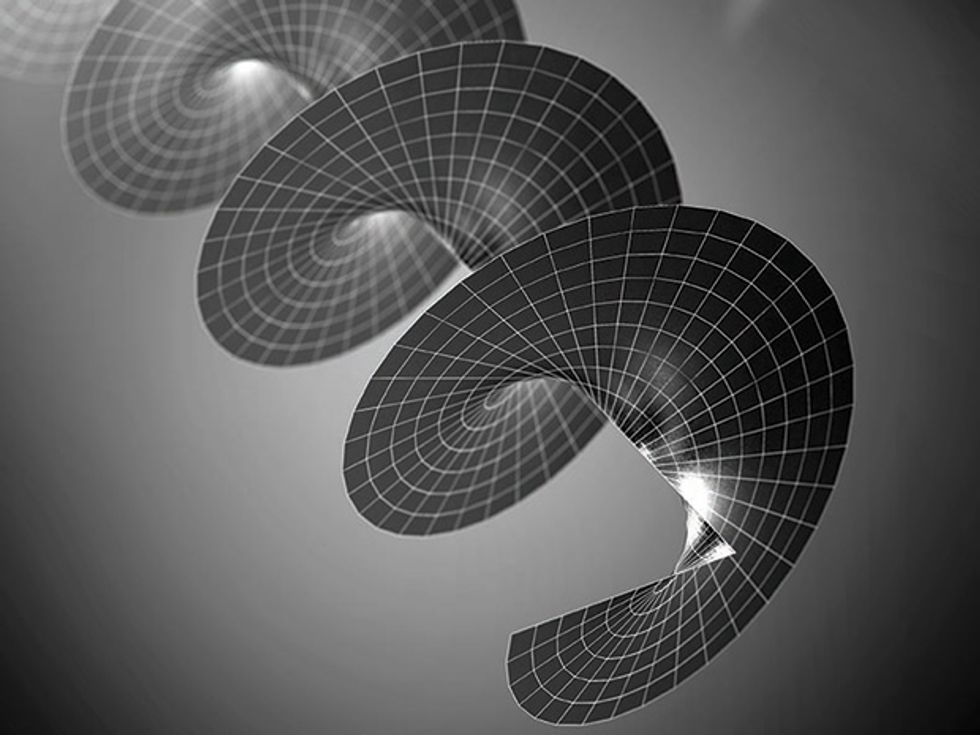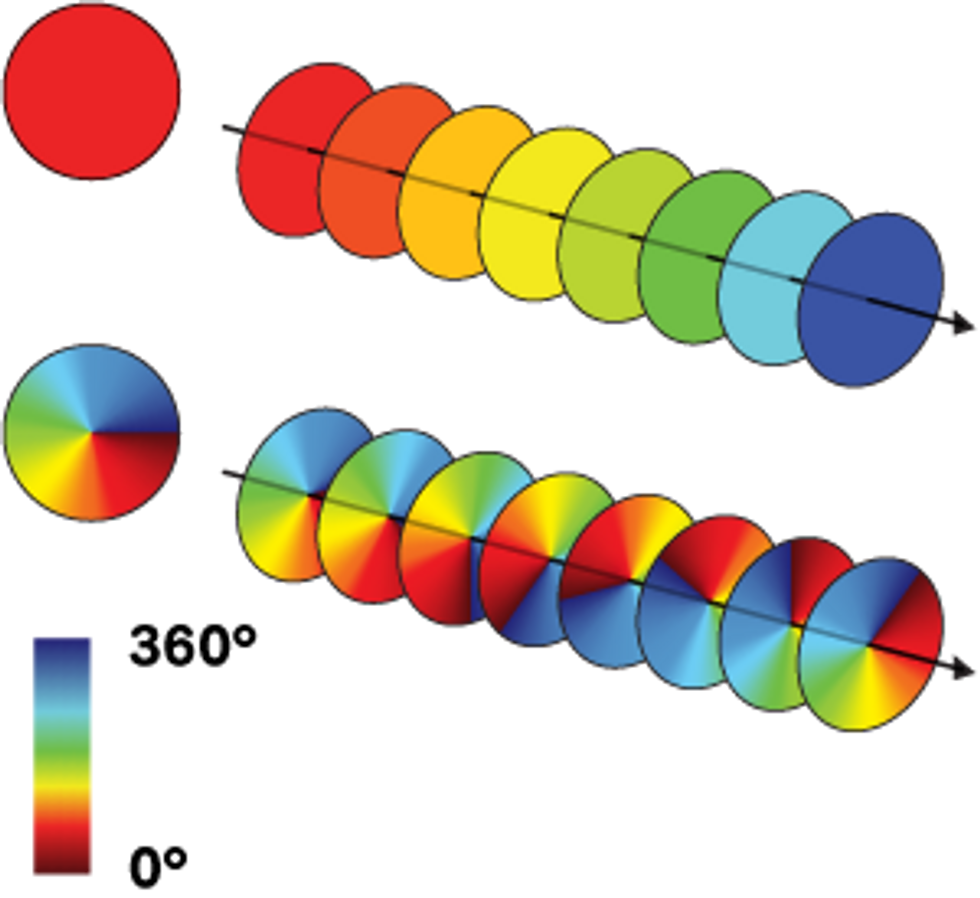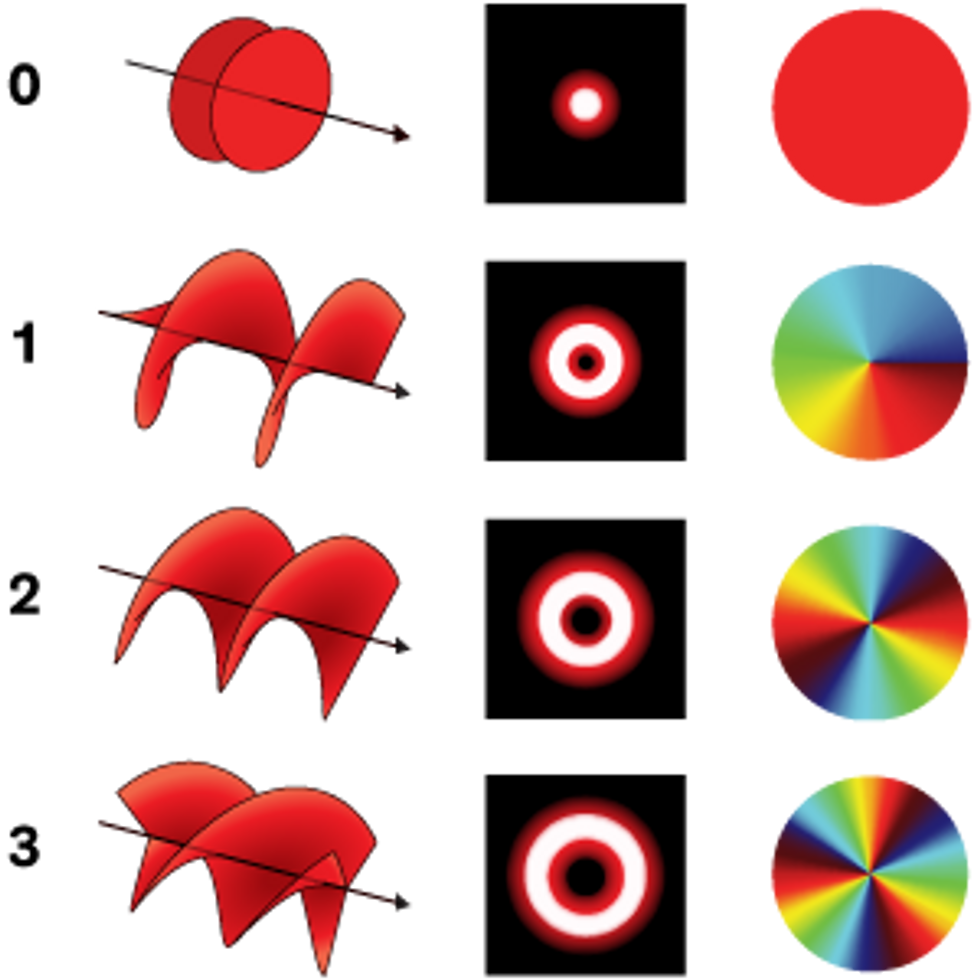Twisted Light Could Dramatically Boost Data Rates
Orbital angular momentum could take optical and radio communication to new heights


It was just 24 years ago that researchers reported the discovery of something remarkable about light: Certain beams, traveling through space with a spiraling pattern suggestive of a corkscrew, carry a form of momentum called orbital angular momentum.
Big deal, you say? It most certainly was. The concept of orbital angular momentum (OAM) has done nothing less than inspire a reimagining of what we’re capable of doing with electromagnetic radiation. Beams that carry OAM can be used to move tiny objects, and they have been used to enhance the resolving power of microscopes.
But the exploitation of OAM may have the biggest impact in my own field of communications. OAM waves with different “twists” don’t interfere with one another. That means they can be overlaid one on top of another to carry a theoretically unlimited number of different data streams at the same time. Hardware that can transmit and receive even a few such OAM beams could dramatically boost the capacity of optical and radio transmissions without placing any more demands on the crowded electromagnetic spectrum than we do today. Indeed, my team at the University of Southern California, in Los Angeles, and others have performed experiments to test this idea, and they worked just as the theory predicted.
If OAM communications sounds familiar, you may have noticed the news a few years ago when one of the first OAM radio demonstrations was performed. At the time, some engineers argued that the approach wasn’t new and was instead just a version of another strategy for sending multiple waves at the same time. But since then, it’s become clear that OAM transmission really is a novel and powerful technology, one that could allow us to transmit much more information along wireless connections and dramatically speed up parts of the networks that underpin the Internet. The technological challenge is finding good ways to harness OAM. We are finally starting to do just that.
A Tale of Three Beams
The oscillation of electric fields can create linearly [left] or circularly [right] polarized light. In both cases, if the beam is a plane wave, the phase—a measure of where the electric field is in its oscillation between peak and trough—will be uniform at every point in the beam’s cross section (a phase of 0º is shown here).


Any form of electromagnetic radiation, whether in the radio, visible, or another part of the spectrum, can have OAM. But for the purpose of explaining what OAM looks like (and to avoid writing out “electromagnetic radiation” every time we do so) we’ll simply use the term “light.”
One of the most curious aspects of light is that it has energy and momentum, just like an ordinary physical object moving through space, even though it doesn’t have mass. And just like an ordinary physical object, when light strikes something, it exerts a force. A solar sail, for example, takes advantage of this property as it accelerates through space, pushed by sunlight alone. Light carries that “pushing” capacity—its linear momentum—along the direction it’s moving. But light can also have angular momentum.
For a long time, the only commonly discussed form of such momentum was spin angular momentum. To understand how it works requires a bit of background on polarization. A ray of light has an electric field associated with it that oscillates perpendicularly to the direction of the ray. In light that is linearly polarized, the electric field oscillates along a fixed line. Light that is circularlypolarized has an oscillating electric field that rotates around the direction the light moves in. Such circularly polarized waves have spin angular momentum, the electromagnetic equivalent of a spinning top or a planet rotating on its axis. Remarkably, this form of momentum can also impart a torque: Shine light with spin angular momentum on a microscopic object and you can make it rotate.
In 1992, physicist Les Allen, working with Han Woerdman and colleagues at Leiden University, in the Netherlands, pointed out that a certain spiraling beam carries another form of angular momentum—orbital angular momentum. If light with spin angular momentum is like a spinning planet, the physical analogue of OAM light could be a planet orbiting the sun. OAM light can also impart a torque, a “twist” that, depending on where the beam hits, can cause a small object to rotate or move in an orbit around the center of the beam.
Not all light has OAM. To have it, a beam must have a particular kind of phase front. Phase is the component of an electromagnetic wave that governs the arrival times of its peaks and troughs. To picture what a phase front looks like, consider a beam of light. If you look at its cross section, it’s easy to view the beam as a collection of a very large number of “miniwaves.” If all these miniwaves oscillate in unison as they propagate—as they do in a common laser beam—the beam is a plane wave, and it has a flat phase front. At any given point along the beam’s propagating direction, the entire cross section has one phase value—that is, all the minibeams are at the peak of a crest, the bottom of a trough, or more likely, somewhere in between.
But there is no rule demanding that different parts of a light beam all have the same phase. In the case of a helical wave, the sort that carries OAM, the miniwaves in the cross section of the beam aren’t uniform. Instead, the phase of each miniwave depends on its angular location around the center of the beam. If you were to trace a circle around the center, the phase would either steadily increase or decrease as you go around.
Phase in Motion

To give a more intuitive feel for how this translates into a “twisting” beam, think of those miniwaves as they move through space. At first, all the miniwaves that are at their peak will lie along some angle, like the hand on a clock. A short time later, those miniwaves will no longer be at their peak; instead, the peak will have advanced, like the clock hand, to another set of miniwaves at another angle around the circle. This process continues, so that if you track the angular location of the miniwave peaks, the wave appears to twist as it moves. To get a better sense of how this phase behavior translates into what looks like movement, consider a neon sign with individual bulbs timed to turn on and off in sequence. With the right program, the neon light can look as if it’s moving in one direction, even though none of the bulbs move. The same is true for OAM. Each miniwave in a beam oscillates steadily, but the time sequence at which each miniwave peaks makes the phase front twist, describing a helix as the beam moves.
Crucially, the more dramatic the phase shift as you move in a circle around the cross section of the beam, the bigger the twist and the higher the amount of OAM. Phase changes around the entire circle can come in integer multiples of 360 degrees.
Such a twisting, helical wave is hard to visualize, but it does produce a clear visible effect. Unlike a conventional beam, which is brightest at the center, the cross section of a helical beam has a ringlike shape, with a dark center. This happens because the center of the beam is full of miniwaves with every possible phase, and a miniwave at its peak is very likely to overlap at least in part with a miniwave at its trough. The opposing pairs cancel one another out through destructive interference.
Helical waves—also known as vortex beams—were known to exist before 1992. But the realization that they carry OAM, as reported in Allen’s paper, was a profound discovery about light, something physicists thought they knew pretty well. For about a decade after the Allen paper was published, a small group of people, mostly physicists, studied OAM and tried to understand its fundamental nature. But since then, the number of researchers involved and technical fields affected have grown dramatically; according to Google Scholar, more than 5,000 scientific papers that discuss OAM were published in 2015.
Twists, Ascending

One of those fields is communications, and that’s because of a powerful property of OAM: Overlapping beams with different values of OAM essentially behave as if they can’t “see” each other. To use the parlance of communications engineers and physicists, those OAM beams are orthogonal to one another. This means that each beam is distinct. It can’t be constructed using beams with other values of OAM, and it isn’t intrinsically capable of interacting with those other beams.
This orthogonality means that OAM beams can occupy the same space without interfering with one another. In fact it’s theoretically possible to use an infinite number of beams, each with a different value of OAM, to carry signals. In practice, there are limitations, as there always are. We’ll get to some of those shortly. But the upshot is that we should be able to overlay many beams of the same frequency on top of one another (multiple polarizations can be used as well). This is good news for communications in general, and especially good news for radio communications, where spectrum is a particularly precious commodity.
A major step forward for OAM communications occurred in 2004, when physicist Miles Padgett and his colleagues showed that OAM waves could be used to encode data, by using different values of OAM to represent information. Later, it became clear that a beam with a single fixed OAM value could act as a data channel—that is, it could be modulated in a variety of conventional ways to carry information. The most straightforward of such modulation methods is on-off keying, which uses the presence and absence of a beam to represent “1” and “0” data bits.
The 2004 work kicked off a number of investigations into using OAM for communications. My group started research on the subject in 2009, when we received funding from the U.S. Defense Advanced Research Projects Agency’s Information in a Photon program, which set out to explore the limits of optical photons for imaging, sensing, and communications. Our first investigation involved building free-space optical links, the sort that can be used to transmit data directly from one computer to another, from one building to another, or possibly between a satellite and the ground.
There are a variety of ways to create and transmit helical beams. We chose a conventional approach, built with as many off-the-shelf components as possible. The transmitter generates regular laser beams, which are then passed through a spatial light modulator, based on liquid crystal, in order to impart a twist to the beam. At the receiving end, each OAM beam was converted back into a regular plane wave by passing it through a spatial modulator with the inverse pattern. The data could then be recovered by a conventional optical receiver.
Making the Twist

In 2012, we published our first journal article on this approach. Our experiment sent 32 different optical beams of the same frequency, each carrying 80 gigabits per second of data, over a modest distance—just 1 meter—in the laboratory. But the total transmission rate, some 2.5 terabits per second, was actually quite high for free-space communications. And it held out the promise for longer-distance transmissions and, because we used only one frequency, much higher data rates.
Our paper on the experiment came out at a curious time. Excitement was building over a public demonstration the previous year by a group of researchers from Italy and Sweden. Following in the footsteps of radio pioneer Guglielmo Marconi, the group sent OAM radio waves some 450 meters from a lighthouse on the island of San Giorgio Maggiore to another building in Venice one evening in June 2011.
But after the team shared its results, a kerfuffle erupted over the true nature of the technology. The main question was whether OAM transmission really was something new, or if it was just another form of the traditional multiple-input-multiple-output (MIMO) transmission found in wireless radio systems today.
Quick background: MIMO uses multiple antennas, each transmitting an independent data stream. Multiple receiver antennas are used to pick up those signals. The transmitters are separated by some distance from one another, as are the receivers. But because electromagnetic beams spread out as they propagate, the different beams usually overlap by the time they reach their destination. This “crosstalk” degrades signals, but digital signal processing that incorporates knowledge of the relative positions of the antennas can counteract the effect.
The disagreement over the Venice demonstration arose because MIMO and OAM both transmit multiple beams that overlap with one another in space, a form of transmission called spatial multiplexing. And at that level, there is no fundamental difference between the approaches. Practically, however, they rely on very distinct ways of minimizing the possibility that one signal could be mistaken for another. While MIMO uses a digital signal processor to undo the effect of such crosstalk, OAM multiplexing relies on the inherent orthogonality of the beams, which can emanate from a single location, to prevent crosstalk from ever taking place. The two technologies are not only different, they can actually coexist; a few years ago we used two different millimeter-wave antennas—multiple inputs—to transmit data on four OAM beams.
Now that the dust has settled on the debate over the novelty of OAM, communications engineers are starting to get more comfortable with the technology. Experiments continue to explore its potential. The research can be roughly divided into three fields: free-space optical links, traditional radio-frequency wireless transmissions, and fiber-optic communications.
The first two, free-space optical and radio, are the farthest along. In the optical category, in 2014, Anton Zeilinger of the University of Vienna and colleagues reported that they had used OAM light to send data, including a grayscale image of Mozart, between two sites in Vienna separated by 3 kilometers.

Although the data rate was extremely slow—just four pixels per second—the demonstration was important because it helped establish that free-space optical OAM communication works despite random variations in air pressure and temperature. Such atmospheric turbulence can alter the phase of the miniwaves in the optical beam by varying amounts, so that a beam transmitted with one OAM value may appear to have different values of OAM at the receiver.
Digital signal processing and adaptive optics—which can use a separate beam to measure the atmospheric effect so it can be corrected—can help with this problem. And a recent experiment by the Vienna group has demonstrated OAM transmission across an even longer distance. But it’s unclear yet whether OAM will find its first practical application in optical or radio communications. On one hand, since light in and around the visible range oscillates at much higher frequencies than radio waves do, optical OAM beams can have much higher data rates. However, the utility of optical links is limited by the fact that visible and infrared wavelengths are more sensitive to atmospheric conditions.
That said, there are challenges to radio-frequency communication as well. Because of the fundamental rules of wave propagation, those longer-wavelength beams spread out more than optical beams do. This behavior reduces the amount of power a receiver might get, especially for beams that traverse long distances. Longer wavelengths also mean that both the transmitting and receiving antennas need to be fairly large in order to create the radio beams and pick them up efficiently, an added challenge for creating compact—and possibly even hand-held—systems.
Importantly, for both optical and RF, a key challenge is recovering the signal. If only a small fraction of the beam—say, a 30-degree wedge—is captured, it is difficult to definitively say how much twist the OAM beam has. The center of the beam has the full range of phase change in a small space, but as you may recall, that part of the beam has very little signal. Adding to the difficulty is that while the number of OAM beams is theoretically infinite, higher-order OAM beams—those with more twist—spread out faster than lower-order ones. Careful system design will be needed for practical deployment, and some type of beam steering—which allows a receiver to detect when it isn’t centered on the beam and correct the positioning—will likely be required.
Fiber communications presents its own challenges. When OAM signals are transmitted through glass, temperature changes and bends in the fiber can easily alter the beam’s phase profile so that some of its power shows up as a wave with a different value of OAM. One possible way of mitigating this issue is with a “vortex fiber,” developed several years ago by a team based at Boston University. Instead of using a uniform glass core to guide waves, as normal fiber does, this special fiber contains a waveguide that looks like a ring in cross section. It turns out that the size of an OAM beam depends on the amount of twist it has, so beams with different values of OAM will have different levels of overlap with the waveguide. The level of overlap alters the speed at which an OAM beam can travel down the fiber, which helps reduce interaction between beams with different values of OAM.
Early results are encouraging. But don’t expect OAM-optimized fibers to be used in transoceanic cables anytime soon; if they’re adopted in fiber systems, they’ll likely emerge first in short links inside high-performance computing and data centers.
Whether OAM links catch on or not will depend quite a bit on the hardware that’s used to exploit them. Today’s demonstrations tend to use bulky and expensive elements that are not necessarily optimized for OAM operation. But any practical deployment of an OAM-based system will require new, specially designed, cost-effective, and compact components. Several research groups are working on the elements, such as transmitters and receivers, needed to make this happen. A team at Fujitsu, for example, has reported an array of flat “patch” antennas that can generate and pick up OAM radio waves and which could fit inside a portable system. Others are working on integrated OAM generators and antenna systems for optical waves.
At the same time, OAM technology is advancing on other fronts. One example is in the field of fluorescence microscopy. Here, an ordinary light beam can be used to excite fluorescent molecules, while a ring-shaped OAM beam can be used to de-excite those molecules, except for those that fall in the dim center of the beam. This technique, pioneered by Nobel laureate Stefan Hell, allows the microscope to resolve features in a smaller region than is otherwise possible.
Quantum communication, which can be used to send information far more securely than traditional systems do, can also take advantage of OAM. Today quantum bits, or qubits, can be made of photons that are constructed from a superposition of two possible polarization states—vertical and horizontal. But OAM isn’t just a property of electromagnetic waves; it’s also a quantum property of single photons. A single photon can have many possible values of OAM, which can be used to increase the capacity of a quantum link. Robert Boyd of the University of Rochester, in New York, has demonstrated quantum communication systems that can carry more than one bit per photon by using OAM.
For a field that’s not even 25 years old, OAM research has come a long way. But it’s only just getting started. Ten years from now, we’ll have a much clearer picture of OAM’s potential and a new list of possible applications. And if things go as well as we hope, you’ll be reading about those applications over a connection that has a twist somewhere along the line.
The author would like to dedicate this article to Les Allen, who passed away earlier this year. He would also like to express his heartfelt appreciation to his outstanding students and colleagues for their keen wisdom and selfless help.
This article appears in the August 2016 print issue as “Communication With a Twist.”
About the Author
Alan E. Willner is a professor of electrical engineering at the University of Southern California.